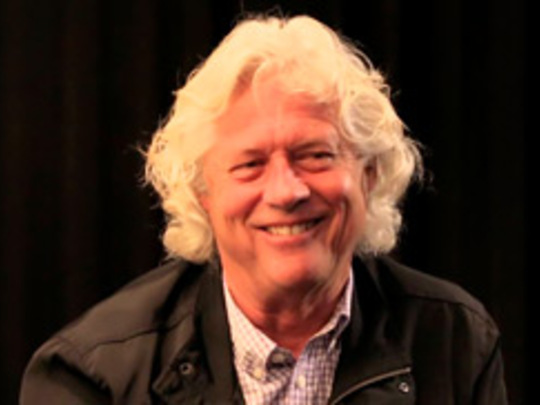
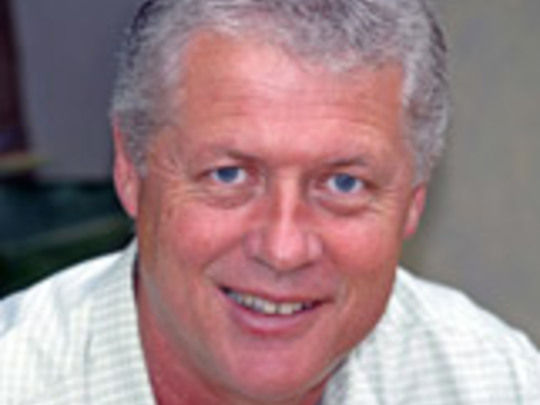
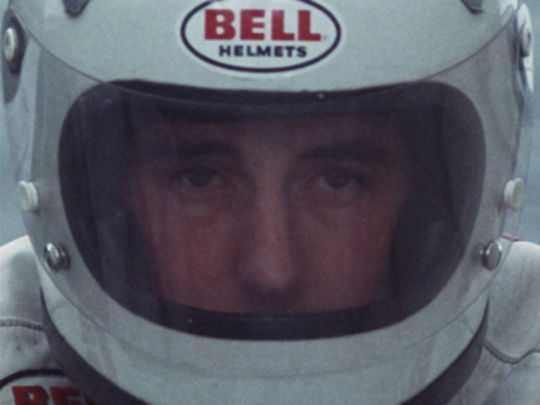
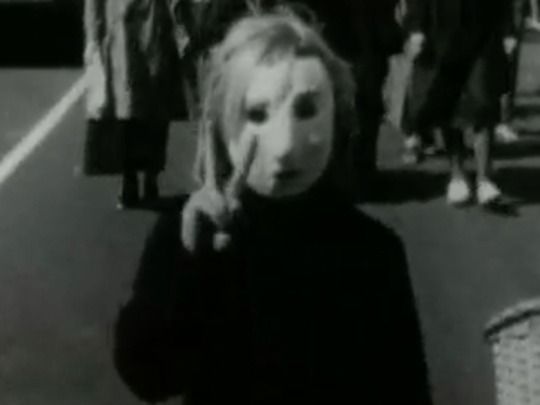
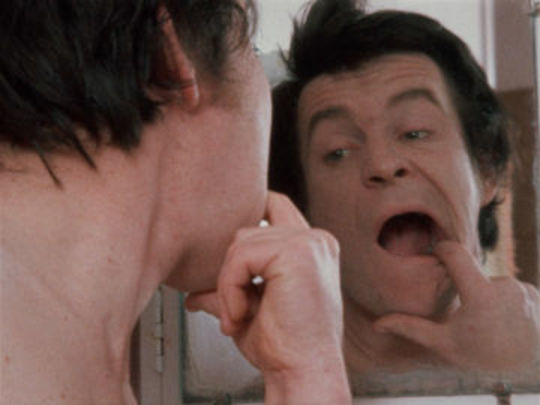
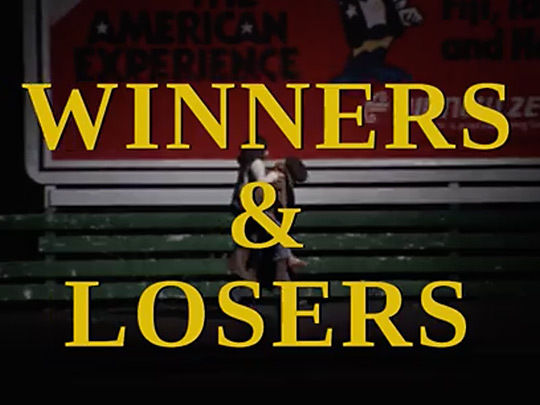
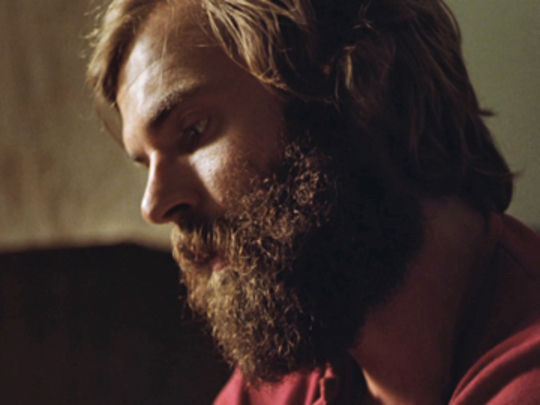

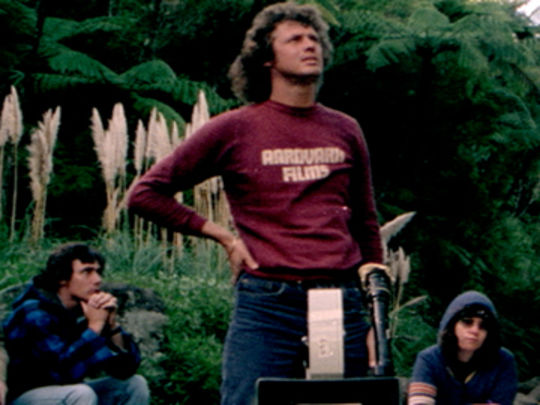
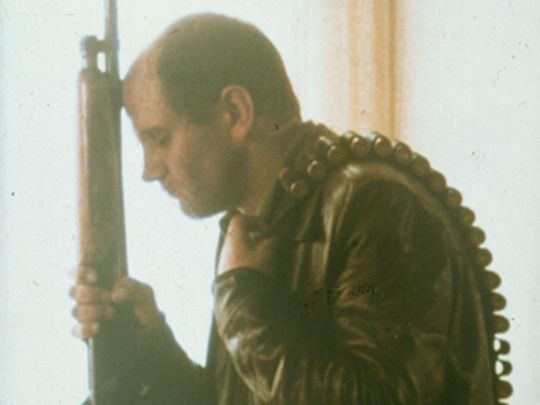
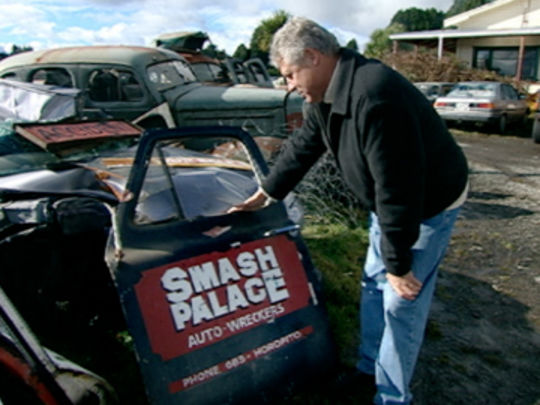
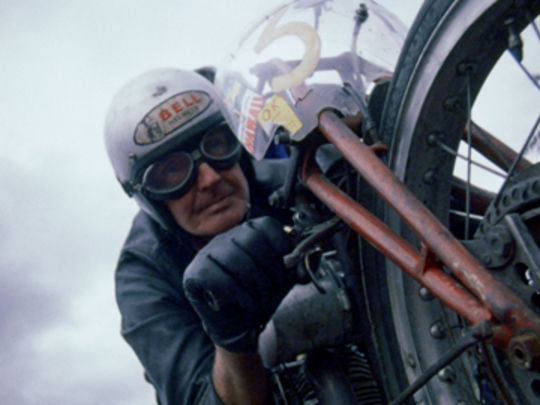
The Roger Donaldson Collection
The Roger Donaldson Collection
This collection has three backgrounds:
Rog - A Personal View
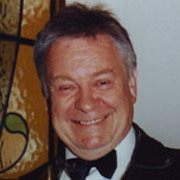
Backing Up the Train - Memories of Smash Palace
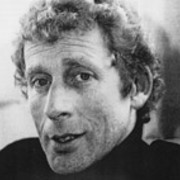
Gumption and Faith - The Work of Roger Donaldson

Rog - A Personal View
By Ian Mune 21 Jan 2022
I’m sure there’s a dozen people to correct me, but this is how I remember it.
For starters — Rog isn’t a Kiwi, he’s an Ocker, born and raised in Ballarat, home of rebellion. He thought Aussie conscription for Vietnam was bullshit so skipped to New Zealand, where, of course, he met and married a bright, bookish and beautiful Kiwi girl, and they had a family of amazing kids. The Kiwification of Roger Donaldson had begun.
Roger’s dad, a car salesman and WWll fighter pilot, was a man of many aphorisms, some of which Roger quotes as mantras to this day…
"The higher they fly, the fewer."
"Second’s last in a two-horse race."
"If you want it done properly, do it yourself."
"You’ll never know if you don’t give it a go."
"Start at the top."
"Just do it."
With thoughts like these ringing in his mind, Rog pursued his passion — stills photography. In 1969, adman Bob Harvey suggested he film Labour Party commercials for the upcoming election. Rog hired a Bolex camera, studied the manual, and shot them, so starting a career in TV commercials. But he had another passion — motorbikes, which lead him to an old geezer in Invercargill who was still perfecting his 1920 Indian Scout, determined to set a world record at the Bonneville Salt Flats. Rog went with him and the result was the documentary Offerings to the God of Speed. Burt Munro understood all Roger’s mantras.
That’s when I met Rog — 1970. I knew nothing about making movies, but I’d heard of him and Aardvark Films. He knew nothing about plays and actors, but he’d seen me in a play at the Mercury. We agreed to pool our talents and find a way to make Kiwi movies. We also agreed that by working together we could get to the point of working on our own. As Rog said, "we’re not married, Mune".
We started, using short ends of film left over from commercials, with a series of skits about a loser who falls into all the traps losers fall into. Somehow we cobbled a story, Derek, out of these, and somehow we persuaded the NZ Broadcasting Corporation to screen it. It upset the hell out of morals campaigners, but it won a Feltex Award and told everyone we were here [Note: Mune writes more about Derek's creation here].
The next step wasn’t easy, with me shuttling between Auckland and Wellington with TV and theatre, and Rog’s documentaries taking him to the Himalayas chasing yetis with Ed Hillary, and round Cape Horn to end up with a broken ankle in a Rio de Janeiro hospital corridor full of corpses. But we took a suggestion from uni lecturer Alan Smythe — soon to become entrepreneur and creator of Christmas in the Park — to adapt Katherine Mansfield story The Woman at the Store as a 30-minute TV play.
There was a shift in the zeitgeist of New Zealand around this time. The NZBC's television operations had split into TV One and TV Two. Alan Morris was running TV One with Des Monaghan as Controller of Programming, David H Fowler ran the National Film Unit, Hamish Keith was Chairman of the Arts Council, and the Education Department could see films becoming more important in kids understanding the world. They were all in. The Woman at the Store took some more Feltex Awards, so we went back to the same trough and got a series of six more episodes based on New Zealand short stories, Winners & Losers. That went well so we took them overseas, and sold them to more than 20 countries [Mune writes more about Winners & Losers here].
The zeitgeist was still shifting (corporate explosions and burgeoning millionaires), and so was Rog. With those mantras in mind he went straight to the top and persuaded Don Brash at Broadbank to cough up 150 grand, a deal that enticed Brash's legal assistant, Larry Parr, into the film industry. Then Rog got the Development Finance Corporation (the DFC) to match that and we launched into Sleeping Dogs.
With Sam Neill playing the lead and me supporting, Rog knew he had to get a name in there to catch the attention of Hollywood. There was a small but significant role for an American. So Rog, still following his mantras, got hold of Jack Nicholson’s agent, offering a fee of five grand — a fortune to us but loose change to Jack. So that was a no. But here’s the rub: Jack’s agent’s secretary was a Kiwi who had boasted of the trout fishing in her native land, and Jack’s agent thought that might be attractive to another of his clients, Warren Oates. Bingo, we had our Colonel Willoughby and a name that would attract the attention of Hollywood.
Although he’s a micromanager who has to do everything himself, Rog can delegate — kinda. Certainly he knows that a smart leader surrounds himself with the right people, people with initiative, people you can say "just do it" to.
— People like Grahame McLean. Rog wanted help from the armed forces, so he told Grahame to just do it. Grahame went to Defence Minister Allan McCready, who didn’t want to know him. Grahame sat outside his office for three days until McCready saw him, just to get rid of him. First up was the script. As it was a story about a dictatorship supported by the armed forces, that looked like a dealbreaker. Until Roger got a call from a Wing Commander who offered a helicopter with pilot, and also a spare seat on a Skyhawk jet that would be doing a rocket run over Muriwai at a very specific time on a very specific date. Rog made himself available.
— Also, people like Geoff Murphy. Rog wanted guns — pistols, rifles, shotguns, AK-47s. And they had to go bang, so he told Geoff to just do it. Rifles and shotguns weren’t much problem, but pistols and AK-47s? Not in New Zealand. Geoff went to the cops and asked for a permit to import dummies from Hollywood. "No way. They might be used to rob a bank." "I’ll keep them locked up and send them back to Hollywood". "Too risky. Go away." So Geoff and his sidekick, Andy Grant, made wooden ones, rigged them up with wires to provide a flash and added the bang later in post.
Halfway through the shoot, with a hundred people filling hotels, motels, baches and spare bedrooms in Coromandel, Rog disappeared. The cast and crew were bewildered, but pleased for two whole days off. What they didn’t know was that we'd run out of money and Roger had gone off to shoot a commercial. When he got back everyone got paid and we all went back to work. He also went back to his funders and asked for half as much again. Don Brash was okay, but the DFC insisted on a punitive 25% interest, guaranteeing that Sleeping Dogs would never break even, let alone make a profit. However, as the zeitgeist kept shifting, the government closed down the DFC, and Broadbank was ready to get this pesky little investment off its books; so Roger bought them all out for a nominal fee, and a few years later I got 500 bucks for my percentage.
Sleeping Dogs sold pretty much all over the world, but it didn’t get Rog into Hollywood. Rog didn't let that stop him. He got a script together, cast Bruno Lawrence, and Keith Aberdein, and made Smash Palace. I was paying my own bills acting in TV series Moynihan and writing a novel, The Mad Dog Gang, which later ended up on TV, so I had nothing to do with Smash Palace. Rog was on his own.
Smash Palace did the trick. Not just for Roger, but for Bruno as well. It caught the attention of Hollywood producer Edward R Pressman (Badlands, featuring Warren Oates and Sissy Spacek). He booked Rog to direct the sequel to Conan the Barbarian. Rog called me over from his house in the Hollywood Hills to help on the script. It was a weird project for us, but fate leant a hand. Ed sold the project to Dino De Laurentiis. When Rog was called in for a sparrow's fart meeting with his new producer, he wasn't sure what was going on. Dino said “Conan? Nah, you donna wanna do Conan. You do Mutiny onna da Bounty.”
The rest is history.
- Ian Mune made on and off screen contributions to Derek, Winners & Losers and Sleeping Dogs. His directing CV includes Came a Hot Friday and Billy T: Te Movie. His screen acting CV runs to 70+ roles.
Backing Up the Train - Memories of Smash Palace
By Keith Aberdein 21 Jan 2022
Unlike Las Vegas, not nearly enough that happened in the Avalon bar stayed there. It’s the 1970s. An important television executive is borderline boasting how he’s invested TV One money in a Kiwi movie. The deal is special — different. A producer present explains why the deal is not so good: the investor rewards from exhibitor deals are not always what they seem. The producer knows a thing or two about such matters.
The Kiwi feature in question was Sleeping Dogs. Roger Donaldson and his then moneyman, Larry Parr, had convinced the Avalon exec to tip a little cash into their collection plate. Apart from that accurate prediction about the money TV One was never going to get back, the channel’s gamble triggered a vendetta that’s rumoured still to get honourable mentions in Sicilian and Camorra case studies. When Tony Williams and John O’Shea were refused Avalon investment for Solo, they neither forgave nor forgot.
Remember: then as now, and maybe even more so, Auckland was another country. Roger Donaldson came from Auckland. His being born in Ballarat merely delivered on the perfect double negative — an Aussie conman from Auckland. For those in Wellington, he had a couple of other dubious advantages. He was a bit good-looking, drove an Aston Martin and was cunning enough to claim that Sleeping Dogs was NOT a political film.
Roger may have forgotten he said that, but we marvelled at how it must have confused Muldoon. The PM had demanded a private screening, possibly to see how a police state actually worked. It was coming soon with the Springbok tour. Muldoon was also a bit miffed that his Skyhawks and their anti-guerilla missiles had featured without his prior and personal permission.
Clearly, Roger wasn’t just a guy who made TV commercials with pretty people running through the sand dunes in slow-mo. He was someone who was confident enough to ditch Karl Stead’s original novel title — Smith’s Dream. It’s also likely that nothing would have changed had he known about Karl’s alternative, happier ending. Apart perhaps from the movie taking more money. Maybe even paying back Avalon. But it wouldn’t have been taken so seriously. In 1987 on No Way Out, he insisted on retaining a key revelation involving Costner's character in the final scene. Cost millions, the studio claimed.
And another thing: back then, Roger wasn’t obeying the great New Zealand commandment. As a nation, we believed in the Holy Trinity of Ed Hillary, Charlie Upham and Colin Meads— and also in taking turns. But the Aussie/Auckland marauder had his hand up again; he wanted NZ Film Commission money for something called Smash Palace. Not a lot, because he was going to shoot it on 16mm.
Anyone who has ever tried to finance a movie — especially in New Zealand, and particularly back in 1978 — understands the simple equation: if he/she/they get to make a movie, then I’m less likely to. It was still a bit of a dark secret that film investment could be tax-rorted. So Film Commission cash was vital.
Making investment decisions on the basis of someone’s opinion about the written script is, we know, notoriously dangerous. The NZ Film Commission perhaps had reservations about the process, since in the 1970s it paid $50 per assessment. The assessment had to include a reasonable synopsis to prove the assessor had actually read the thing.
Anyway, the script for Smash Palace was out for an opinion. Anyone paying attention to the Kiwi movie trivia of the time may already know this tale. Apologies. By chance or design, something called Goodbye Pork Pie was also being assessed. One of the assessors had both scripts and wrote his reports on the same night — a whole hundred bucks for an evening’s work.
In the spirit of full disclosure, this assessor was aware that certain individuals within the Film Commission did not like the anti-social, bad-driving heroics of the hoons in the yellow mini. He knew this because a friend had told him. The friend was also the man trying to get Goodbye Pork Pie funded — writer/director Geoff Murphy. He needed a supportive review to subvert the forces of the discomfited.
Murphy will tend to worry the powers-that-be throughout his long and interesting career. But on that 1970s night he gets the assessment he hopes for.
The Smash Palace screenplay, on the other hand, seems to have a few problems. Like the Sam Neill character in Sleeping Dogs, this one also features a man in a dying marriage. But this time without the distractions of guerrillas and riot squads. The marriage disintegration is central.
Years later Roger will publish a collection of his photographs. It’s called All Dogs Shot. The tone and some of the detail of the early Smash Palace draft was much closer to that title. There was, for example, a scene in which the 'wronged' husband forces his treacherous mate to drink a cup of his urine, as revenge for sleeping with his wife. The assessment suggested that perhaps the Donaldson project wasn’t quite ready yet…
OK, I was that assessor. Writing my negative review, I had no idea there was any possibility I’d be playing the cop faced with a warm cup of Bruno Lawrence. I also had no ethical difficulties in supporting Pork Pie. It looks a bit creaky now, but on paper some 40 years ago, it worked. Equally, my worries about Smash Palace were real, and probably right. The script Roger eventually shot was very different from the draft on which I’d laid my poison.
That Roger forgave me for my assessment — even at times would quote it — suggests what sort of human being he was, and still is. The fact that every time that wire-looped shotgun was about to go to my throat I checked it wasn’t loaded had nothing to do with the possibility that Roger — or someone — might want to blow my head off. It was just simple, paranoid common sense. And Roger was unhappy with the level of violence Bruno used the first time he took me hostage with the shottie-garrotte. So finally Roger did it himself. A satisfactory violence was duly achieved. [Note: Aberdein writes about actor Bruno Lawrence here].
Smash Palace was, as it turned out, Roger’s ticket to join the bigger kids. But it was a film he seemed to care about, rather than what became the more standard motivation of making movies primarily as Hollywood calling cards and potential career moves.
For the record, a glance at the Donaldson filmography between Dogs and Palace finds there is something called Nutcase, and an episode of series TV — Jocko. I played an armed offenders’ cop in that Roger-directed episode.
In the Roger-directed Nutcase, Ian Mune and I actually shared a healthy creators’ percentage of the profit points. Never seen a cent. It was a kids’ feature made for the wrong reason — money. We were even going to share in the cinema ice cream and lolly sales. A bit like the deal that Sleeping Dogs sold to that Avalon TV executive. The producer of Nutcase was John Barnett, and it was Barney who’d quite rightly warned the Avalon executive against his investment in Sleeping Dogs.
Yes, I’ve digressed. Though not entirely. It’s a tricky old business. So much shifting sand, and shiftier loyalties. I love the fact of a Roger Donaldson Collection in which I had a minor role, and did my best to end almost before it began. Roger gave me the gift of a part in Smash Palace. I was neither dedicated nor talented enough to be a working actor, but those six weeks in Ohakune are treasured still.
If they work enough, most film directors beget legends. By insisting he watch a son run in the Sydney Olympics, Roger made Geoff Murphy surely the highest paid second unit director ever, by having him take over on Dante’s Peak. And Mickey Rourke, whom, against studio resistance, Roger had fought to cast, arrived on location for White Sands saying "I’m sorry I’m late. But I shot my wife."
In one of my last conversations with Geoff Murphy, we talked about Roger and how, regardless of many other things, his films invariably have a magic. Obviously, we weren’t talking about the Harry Potter thing. For me, looking back and beyond the merely personal, I find the great thing about the man and his movies is that he never does dull, when dullness is so often hailed as seriousness or quality.
Roger’s instinct or ability, no matter the genre or formulaic pressure, somehow manages to give his work the sense that something interesting is about to happen — or just did. Or both. He told me recently he sometimes wonders what the hell he’s thinking, still trying to make movies. But it’s how he wants to spend his days. Why wouldn’t he? There may not be quite the old demand for his famous party trick chicken dance. But then again…
- Failed law student Keith Aberdein began as a journalist, acted sporadically, and has written for a run of screen dramas — including Pukemanu, Utu and The Governor.
Gumption and Faith - The Work of Roger Donaldson

By Dominic Corry 21 Jan 2022
Even under the most generous of circumstances, making a movie requires a massive leap of faith. Which makes Roger Donaldson's mounting of Sleeping Dogs in 1977 all the more impressive, since it was made at a time when hardly anyone believed a New Zealand film could find a large local audience. It no doubt required at least 10 times the usual amount of faith-leaping.
Although there are plenty of notable antecedents by a range of Kiwi screen pioneers, Sleeping Dogs is the earliest example of what we recognise as a contemporary commercial film made by locals in New Zealand. The pure, ground-up gumption that drove Donaldson to get it done has served him well throughout a career as one of our most successful and prolific filmmakers, both here and overseas.
Arriving in New Zealand in the mid-60s, the Australian-born Donaldson was working as a photographer (TVNZ's Breakfast covered an exhibition of his photos in this report) when he set up production company Aardvark Films, through which he moved into directing commercials.
He channelled the profits from those commercials into documentaries like 1972's Start Again (viewable in full here), which follows city dwellers ditching the fast lane for a simpler life. It's some pretty classic Kiwi hippie stuff, and definitely informs the "going bush" aspects of Sleeping Dogs.
Other documentaries Donaldson made in the early 70s include motor racing tale Geoff Perry and the thrilling The Adventure World of Sir Edmund Hillary - The Kaipo Wall (part two is here), which chronicled Hillary's expedition to conquer the titular rock face in Fiordland. You can already sense Donaldon's "get it done" qualities, and his clear talent for knowing how to get the best out of his footage.
He next moved into more scripted narrative, with early efforts like controversial 1974 TV drama Derek and the groundbreaking series Winners & Losers in 1976, an anthology drama with stand-alone episodes adapted from Kiwi short stories. These projects proved a warm-up for Donaldson and regular collaborator Ian Mune; they next moved forward with Sleeping Dogs, adapted from CK Stead's novel Smith’s Dream.
Sleeping Dogs was one of the first Kiwi features to gain a release in the United States, Donaldson famously lured American actor Warren Oates (of The Wild Bunch and Bring Me the Head of Alfredo Garcia fame) down to play a supporting role on the promise of a fly-fishing holiday, knowing that Oates' involvement would open the film up to wider distribution avenues. It's an amusing, early example of Donaldson’s always-sharp commercial instincts marrying up with the creative problem-solving inherent in the best directors.
Made to support the film's initial release, Dream in the Making - The Making of Sleeping Dogs documents the shooting of the politically charged film, while this longer 2004 documentary sees Donaldson and his key collaborators gather to look back at the landmark film, and features plenty of classic Warren Oates stories.
Press footage from the Sleeping Dogs premiere (which you can see in the third clip of this documentary) saw Donaldson (accurately) staking nothing less than the continued existence of a New Zealand film industry on the success or failure of the film. It proved a lightning-rod moment for Kiwi cinema, and its positive reception helped pave the way for further classics like Goodbye Pork Pie. But Dogs’ success didn’t mean it was any easier for Donaldson to mount a follow-up film.
In fact, as he explains in this episode of Kaleidoscope, mounting a second feature was even harder than getting his first film made. But Donaldson kept busy in the intervening four years, directing Nutcase, a bizarre sci-fi one-off aimed at children in 1980.
He also directed this episode of rural TV drama Jocko. Once again, Donaldson's Hollywood-friendly visual flourishes are evident — the opening shootout features action worthy of a John Woo film.
Bruno Lawrence guest-starred in that Jocko episode, and the Kiwi acting icon would go on to play the lead in Donaldson's eventual second feature Smash Palace, which debuted at the Cannes Film Festival in 1981 before general release the following year. The film's trailer and an excerpt can be seen here, and a 2004 look back at the making of the movie is here. Donaldson also features in this 2000 doc about Bruno, Numero Bruno.
Donaldson found time during this period to direct music videos, like this one for Monte Video and the Cassettes, famous for their previous novelty hit 'Shoop Shoop Diddy Wop Cumma Cumma Wang Dang'. Trivia time: Monte Video frontman Murray Grindley also wrote the jingle for the famous Crunchie train robbery commercial, while Donaldson directed the equally iconic "Any last requests?" Pixie Caramel ad.
Although it continued Donaldson’s interest in solitary men, Smash Palace was a quieter, more introspective movie than Sleeping Dogs. It went down particularly well with critics in America, with no less an authority than Roger Ebert calling it one of 1982's best films.
The acclaim helped Hollywood to really pay attention to Donaldson, and after a meeting with legendary Italian producer Dino De Laurentiis about a Conan sequel went pear-shaped (De Laurentiis, addressing Donaldson as "Donald", called Donaldson and Ian Mune's script "a piece of shit"), Donaldson was invited to direct De Laurentiis' stalled remake of Mutiny on the Bounty. The film was eventually titled simply The Bounty — with Donaldson replacing no less a luminary than David Lean in the director's chair.
De Laurentiis had already built the titular vessel at great expense for the abandoned Lean version of the film, and it was sitting unused in New Zealand. Knowing this, Donaldson casually inquired about the boat in their earlier meeting, planting a seed in De Laurentiis' mind which resulted in him being offered the film the next day. The complex process of getting the boat up to Tahiti for shooting is chronicled in doco In Bligh’s Wake.
The Bounty, starring Mel Gibson and Anthony Hopkins as Fletcher Christian and Captain Bligh, was by far Donaldson’s largest undertaking, and the pioneering spirit that informed his early work helped keep the gargantuan production…afloat. Donaldson was now in the big leagues.
He discusses the challenges of making the transition to larger scope filmmaking in the 1985 Kaleidoscope episode. He also has a large role to play in a notable Kaleidoscope episode from a couple of years later, which features an interesting survey of the previous decade of Kiwi cinema with hilarious commentary from film critic Nicholas Reid — author of 1985 book A Decade of New Zealand Film – Sleeping Dogs to Came a Hot Friday. Reid at one point celebrates the "hooning, rooting" fun offered by Ian Mune's Came a Hot Friday.
Mune was once again Donaldson’s co-writer on the script for The Bounty, and the pair's long creative partnership is covered in a 2007 TV documentary about Mune, The Life of Ian.
With The Bounty having established Donaldson’s ability to command an epic-scaled film, he was able to start getting more work in the States. His first purely American effort, the Sissy Spacek corruption drama Marie, didn’t make a huge splash, but his subsequent film No Way Out — a taut espionage starring Kevin Costner and Gene Hackman — was a big hit, solidifying Donaldson’s reputation as a helmer of elevated, polished commercial cinema.
Over the next 20 years, he directed multiple hit films (including Cocktail, Species and Dante’s Peak) plus another bonafide classic in the form of Cuban missile crisis drama Thirteen Days, which reunited him with Costner. In the 1999 TV doco Coming Home, made while Donaldson was preparing to shoot Thirteen Days, he discusses his transition to Hollywood filmmaking, marvelling at going from working with a crew of 80 on Smash Palace to more than 3000 on Dante’s Peak.
But Donaldson never left New Zealand behind, and he returned in 2004 to shoot The World’s Fastest Indian (a trailer, excerpt and a making-of doco can be viewed here) about singular Kiwi motorcycle nut Burt Munro, whom Donaldson had previously made a documentary about in 1971. You can see Donaldson on the set of the film in this episode of entertainment news show Headliners.
He followed Indian with the delightful British period gangster flick The Bank Job in 2007, before making Nicolas Cage vigilante drama Seeking Justice then spy thriller The November Man with Dante’s Peak star Pierce Brosnan. It speaks well to Donaldson's directorial prowess that his stars (Hopkins, Costner, Brosnan) keep coming back to work with him.
Donaldson's affection for fast vehicles reared its head again in 2017 feature documentary McLaren, which told the amazing story of Kiwi racing great Bruce McLaren.
And Donaldson's not done yet, with various projects being developed. Behind his historic contributions to our modern film industry, he stands tall as a living embodiment of the notion that a Kiwi director can have continued success overseas and not lose touch with his roots, both creatively and culturally.
- Dominic Corry writes about film for The NZ Herald and Flicks, and is Editor-at-Large for website Letterboxd.